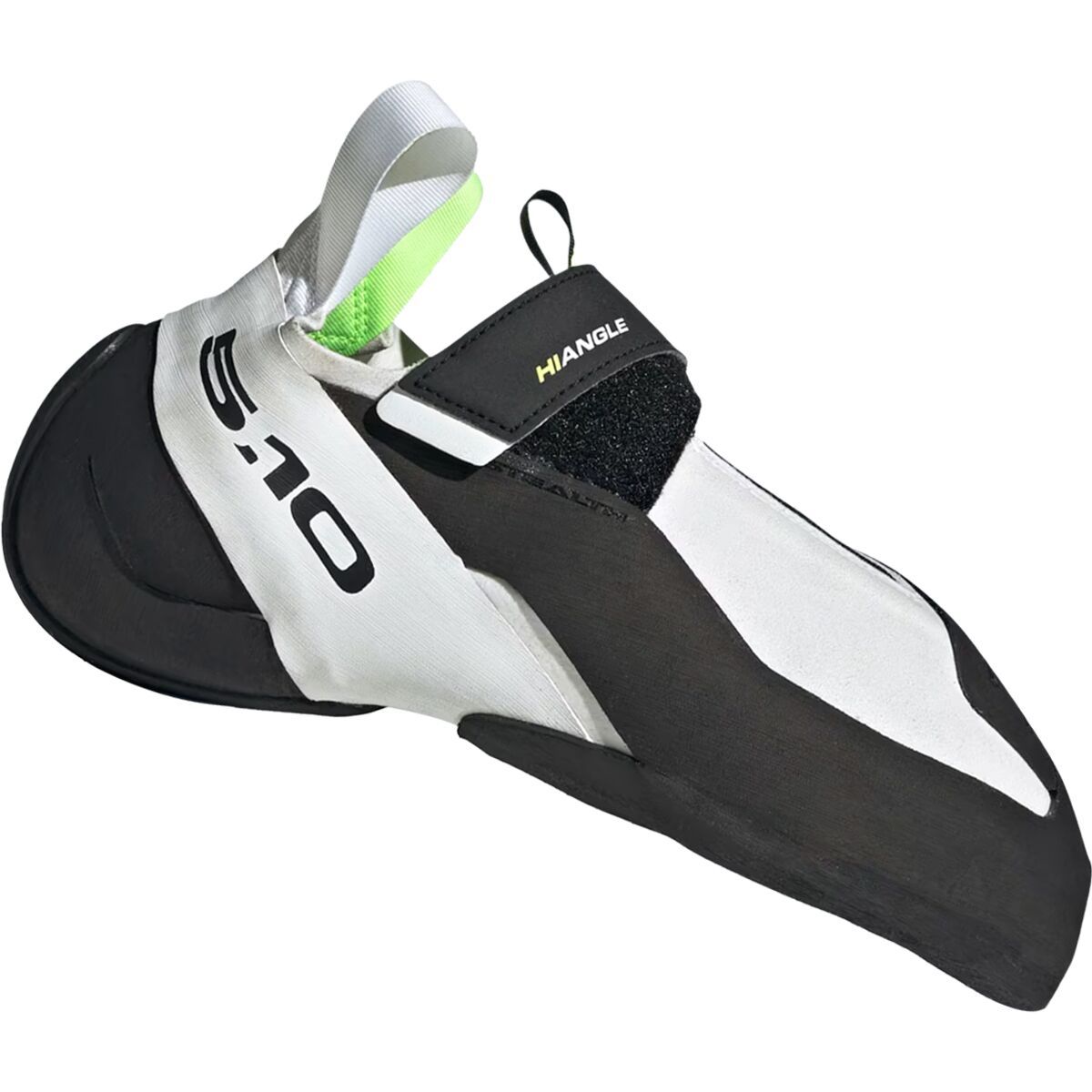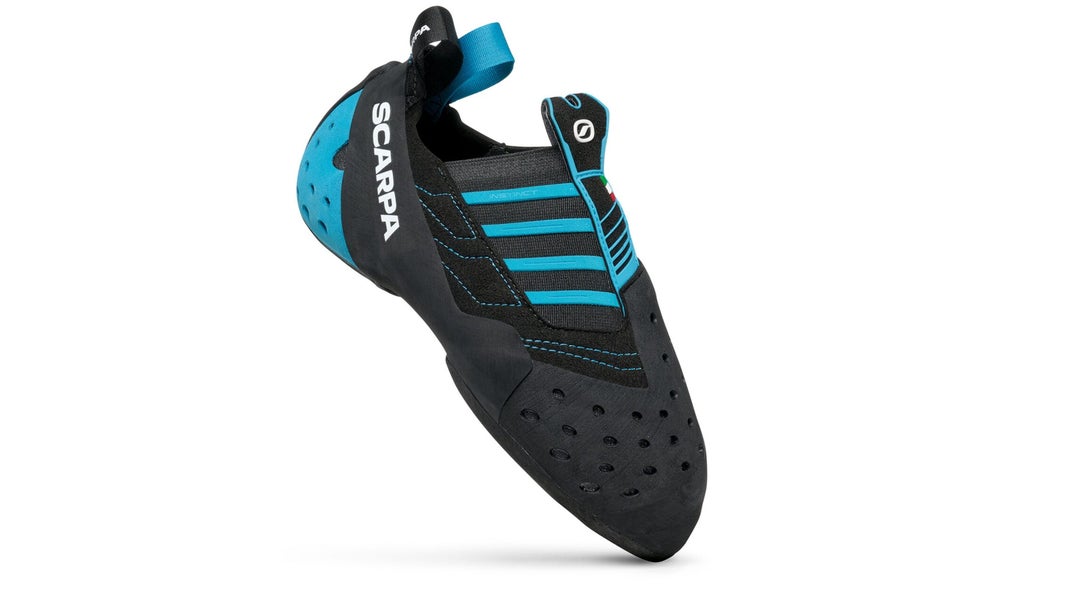Heading out the door? Read this article on the new Outside+ app available now on iOS devices for members! Download the app.
Bouldering shoes come in all shapes and sizes. The model that’s best for you depends on a variety of factors, including on your body type, climbing style, how hard you climb, the type of rock you climb on, how many different pairs you want to own, and how much money you want to spend. But for the sake of this article, we’ll assume that when someone Google’s “bouldering shoe” they are looking for a performance shoe, something that’s built for a specific kind of (generally steep and hard) climbing.
Here, we’ve compiled ten of our favorite bouldering shoes—and a list of ten things to think about when buying climbing shoes.
Section dividerTen Things You Need to Know About Climbing Shoes
1. Comfort is not king.
Fitting your climbing shoes for comfort is like buying a car because you like the driver’s seat. I’m not saying is that climbing shoes should be uncomfortable, per se, but I do believe that buying for comfort first isn’t wise. A few exceptions exist, however, where comfort should be top priority: for kids, because their feet are still developing and they just need to have fun; for absolute newbies who don’t need the distraction of less-than- comfortable shoes. If either of these situations sounds familiar, get the comfiest pair of kicks imaginable, let ’er rip, and stop reading. For the rest, keep on.
Having trouble finding a performance shoe that’s even tolerable? Check out “Eight Tips for Fitting Rock Shoes to Your Problematic Feet.”
2. Performance matters.
If you’re bouldering (which, if you’re reading this article, I’ll assume you are) you’ve got to think about what kind of performance you’re looking for. Do you want a rigidly aggressive shoe that’ll do well on the edgy boulders in the buttermilks while also allowing you to toe in on roofs in the Happies? Consider the La Sportiva Solution or the Scarpa Instinct VS. Are you looking for something softer that will perform equally well on 3D Yosemite smears, the volumes in your next comp, and some pocketed limestone roof? Maybe go with the Butora Acro or the Ocun Nitro.
3. Have two pairs of shoes (at least).
Most of our editors bring three pairs of shoes to the boulders, and so does almost everyone who takes climbing seriously. (Two is the bare minimum.) There’s no such thing as an all-arounder, really. Thinking one shoe can do it all is like trying to shoot your best round of golf with only a five iron. Also, shoes are expensive. You shouldn’t be warming up or doing end-of-day mileage in your sparkling new $200 send shoes.
4. Foot shapes are different.
Some climbers say they only fit in La Sportiva shoes. Others only use Scarpa. Some people swear by Five Ten while others have traditionally found their heels too small.
When buying a pair of climbing shoes, try out loads of brands—in all different sizes. This probably means supporting your local gear store or gym, which generally have wider ranges of size and selection than their big box rivals. (It’s nearly impossible for me, a men’s size 9, to size down to my preferred Solution size, a Euro 38, in places like REI: they simply don’t stock shoes small enough). Whatever shoe you end up getting, there should be no extra space in the toe box, heel cup, or arch. You should also remember that most climbing shoes are going to stretch out—a lot. Many devoted climbers size their shoes almost intolerably tight at first and then break them in by wearing them around the house (or during Zoom meetings with our bosses), knowing that, with time, the shoes will be perfect.
5. Flat Shoes
The bottom of these shoes look flat and they’re generally sized so that your toes aren’t so severely crumpled as they are in downturned shoes. In general, flat shoes are excellent for slabs and vertical walls. Flat shoes can be soft or stiff. The stiffer they are, the better they’ll be on harder vertical or slab routes, such as when you need to stand on quarter-inch edges. Softer flatter shoes are good for crack climbing, since they torque well into cracks. They’re also popular with beginners who don’t need high performance, and kids, whose bones shouldn’t be crammed into tiny aggressive shoes. Generally speaking, flat shoes are not ideal for anything steep—but they can be the perfect shoes for less steep boulders. For instance, on his latest beer-and-boulders tour in Squamish, our digital editor Steve Potter carried around two pairs of shoes: a pair of Muiras (a relatively flat shoe typically seen on trad routes and edgy sport climbs) for the granite slabs and a pair of Futuras for the steeper, harder problems.
6. Downturned shoes.
Downturned shoes are designed for overhanging climbs. A downturned shoe arcs like a bird beak and is often (though not always) quite soft, which gives the climber more sensitivity in the toes. Unless you exclusively climb on slabby or vertical terrain, you want a pair of downturned shoes in your arsenal. There are subcategories:
Mildly downturned: A mildly downturned shoe is the closest thing to an all-arounder that you’ll ever see in the shoe world. A great example is La Sportiva’s Muira Velcro, which will get you up techy slabs and performs well on vertical terrain, yet can still toe into pockets and crimps on steeper walls. Similarly, far softer shoes like Tenaya’s Mastia combine softness and sensitivity with a mild downturn to excel on smears and volume climbs while not sacrificing high performance on steeper walls.
Extremely downturned: A rule of thumb: the more downturned a shoe, the more it is meant for overhanging climbing, the reason being it lets you grab and pull in with your toes (for a caveat, see “Asymmetrical shoes”). There’s nothing sadder than seeing someone on a steep route with a flat shoe. For steep bouldering or steep sport routes—anything with an angle over 45 degrees—get an extremely downturned shoe.
Fitting for downturned shoes: These range from “Not so bad” to “Uuugh” to “OMG, take it off, take it off!” Again, they’ll stretch a bit, about a half size. And if you’re bouldering, you only need to wear them for one to five minutes at a time. Remember, if you size these shoes too big, it’s like hobbling a horse’s leg before the race. Very snug to painfully tight is the rule. During fitting, your toes should be crunched and angled downward; this allows you to pull on steeper terrain. The asymmetry in these aggressive shoes further allows your big toe to engage.
7. Stiff shoes.
The term “stiffness” refers not to shape of the shoe but the feel. Stiff shoes tend to have rigid midsoles: this mid-bed stiffness supports your foot, so you don’t have to have strong feet to get the best performance out of them. Stiffness helps you stand on smaller holds with more efficiency and makes it easier it is to generate power through your toes. Stiff shoes can be flat or downturned, and there’s a lot of variation. La Sportiva’s über-classic (and über-aggressive) Solution is a relatively stiff shoe, especially when compared to the sock-like shoes often worn by climbers on volume-heavy competition boulders. The downside of stiff shoes? It’s often harder to grab holds with your toes, which makes them less ideal on steeper climbs where you want to maneuver your toes to grab edges and pockets. They also tend to perform less well on smears, since the shoe is too stiff to conform itself around the features of the hold.
8. Asymmetrical shoes
The term asymmetrical here refers to the shape of the shoe, particularly its toe box. Imagine a twisted banana. The more the tip of the shoe bends away from the center line, the more asymmetrical the shoe. Flat shoes are typically more symmetrical, but never perfectly so. Most highly asymmetrical shoes are also highly downturned. The purpose of the asymmetry is to keep your toes in a crimp position, which helps with digging into holds on steep routes and, with some models, help keep you on small holds on vertical terrain with greater precision, thanks to your big toe doing a lot of the work.
9. Closure Systems
Newer climbers are often surprised to learn that closure systems—generally divided into three categories: laces, Velcro, and slippers—are more than just a preferred way of fastening a climbing shoe to the foot; they actually change the nature of that shoe’s performance.
Lace-up shoes. Lace0ups are less common and popular than they once were, but those of us who love them love them. Here’s why: a lace-up allows the wearer to customize the way the shoe flexes or doesn’t. It basically allows you to alter the fit of the shoe depending on the type of climb—minimizing the need to take multiple shoes to the crag. When tightening the laces down hard, the shoe gets stiffer. By tightening just the top laces, the shoe snugs up in the back, near the heel, but leaves the toes freer to flex in the front of the shoe—a combination especially desirable on steep cave problems where you might be heel hooking but also want to be able to curl your toes over an edge. Conversely, by leaving the whole shoe barely laced at all, you accomplish a slipper-like feeling. In this sense, a lace-up shoe is the most versatile of the three options. But it also has its drawbacks: lace-ups tend to perform far less adeptly on toehooks, since the laces exist in place of the sticky rubber. They also tend to be slightly bulkier than their Velcro and slip-on counterparts, since laces and grommets and tongues take space and weight. And they take a lot longer to put on and take off, which isn’t ideal for bouldering, since if you’re resting enough you’re probably putting your shoes on and taking them off ten times or more per hour.
Slippers. Pure slippers used to be all the rage. In the 90s and early 2000s, the Five Ten Moccasym and V10 were the bouldering shoes of choice by everyone from Fred Nicole to Chris Sharma to Paul Robinson. But in recent decades slippers have become less popular, with even the softest shoes generally having at least one Velcro closure system. Why? Because the big drawback with pure slippers is the obvious one: Heelhook too aggressively and it’s pretty easy to pull your shoe off.
That said, the sensitive, sock-like feel that slippers originally brought to the market has only grown more popular as bouldering and gym climbing increase their market share. Shoes like Scarpa’s Furia S, La Sportiva’s Futura, Butora’s Acro, Ocun’s Nitro, and many others, all traffic in the same highly sensitive, foot-conforming feel. Performing like slippers, these shoes are designed to smear on gym volumes or toe hard into pockets or crimps on steep roofs—but they often do less well on slabbier and vertical terrain, where supported edging is the name of the game.
Velcro. Most of the shoes listed below have some sort of Velcro closure system. But there’s a pretty big difference between a slipper with a single high Velcro strap and a shoe like La Sportiva’s Muira VS, which has three straps across the bridge of the foot. The benefit of a robust Velcro system is simple: it’s more supportive and customizable. As with a lace-up, a multiple Velcro system allows the wearer to decide how much and where to crank down the tightness. The drawback? These straps tend to get in the way when you’re toehooking—which is why a more slipper-like shoe is often preferable when intense toehooks are required.
10. Shoes are expensive; treat them like it.
Climbing shoes are not cheap, but there are things you can do to minimize the wear and tear and prologue their lives.
Keep them clean. Never walk around at the base of the crag in your shoes. And if they do get muddy or sandy, be sure to clean them off before climbing–something that protects both your shoes and the rock from the sandpapery influence of dirt.
Don’t use your project shoes for your warmups or gym sessions. Most climbers don’t train or warm up in their best shoes. If you go through the time to buy and break in a pair of expensive (and agonizing) shoes, why continue to break them down on climbs far below your limit?
Resole your shoes. Read: “Resole Your Expensive Rock Shoes Before It’s too Late”
Section dividerOur Favorite Bouldering Shoes
Note #1: what follows is not a list of 2023’s sparkling new shoe lines; instead, these are our editors’s go-to favorites, the shoes we return to when we’re not out testing new shoes. As such, this list is neither comprehensive nor unbiased.
Note #2: The ordering is alphabetical by manufacturer.
Five Ten Hiangle
Downturned but not too downturned. Soft but not too soft. Stiff but not too stiff. It’s no wonder these shoes are worn by comp luminaries like Janja Garnbret and footwork wizards like Giuliano Cameroni. One tester called these “the Goldilocks of performance shoes” because of the balance between comfort and technical performance. “Wears like a slipper, performs like a Velcro,” said another tester of the single strap, which is placed high over the arch of the foot to lock everything in place. A slightly oversized toe box allowed testers’ toes to have room to curl up so they could wear them for long gym sessions and only take them off a few times. Meanwhile, thanks to the siping (gills) on the scum patch and split-sole design, helped also by the super-sticky Stealth C4 sole, the new Hiangle (it got an upgrade in 2020) flexes more than its predecessor for smearing—just the perfect amount.
Fit. Even though it will stretch slightly over time, the sizing is quite small. One tester even went up in size off his street shoe.
Price: $150 (On sale for $128 right now)
Buy the Women’s Hiangle at Backcountry
Buy the Men’s Hiangle at Backcountry
Want something more gym focused? Check out our review of the Hiangle Pro
*

La Sportiva Mantra (NEW!)
As the lightest and softest shoe La Sportiva makes, the Mantra is designed for those who value sensitivity and foot dexterity above all else. It’s great for board climbs, for friction slabs, and for grabbing at holds on steep overhangs.
As our reviewer noted: “The Mantra is a funky shoe at first glance; one tester called them ‘torpedo shaped’ and found them to be overwhelmingly soft. Indeed, the Mantra can be folded in half—front-to-back or side-to-side—with just two fingers. The Mantra is maybe the closest thing to coating your foot in rubber and little else, and perhaps unsurprisingly we found climbing in it took some getting used to. The Mantra offered very little support on edgy slabs and technical faces, and we had to recalibrate our wimpy climber feet to carry their own weight instead of relying, as is typical in almost any other climbing shoe, on the stiffness of a midsole to stand tall on small edges. This learning curve was short lived once we realized wearing the Mantra is a lot like climbing barefoot—except stickier and less painful. I could splay out my toes on slick volumes, grab bulbous holds on the steeps, reel in heel and toe hooks on powerful aretes, and smear up friction slabs both indoors and out. The Mantra has few downsides (the number of which is dependent on personal preference) but our testers unanimously found it weak on edging-intensive climbs due to its rounded toe and lack of support.”
In sum: This is not an all-arounder. But it has a beloved place in our quiver. It’s great for steep boulders and smearing on slabs or volumes. It’s not so great for edging.
Sizing: Size wise, the Mantra fits squarely into La Sportiva’s line up: not particularly narrow nor especially wide.
Price: $169
Check out the full review here.
*
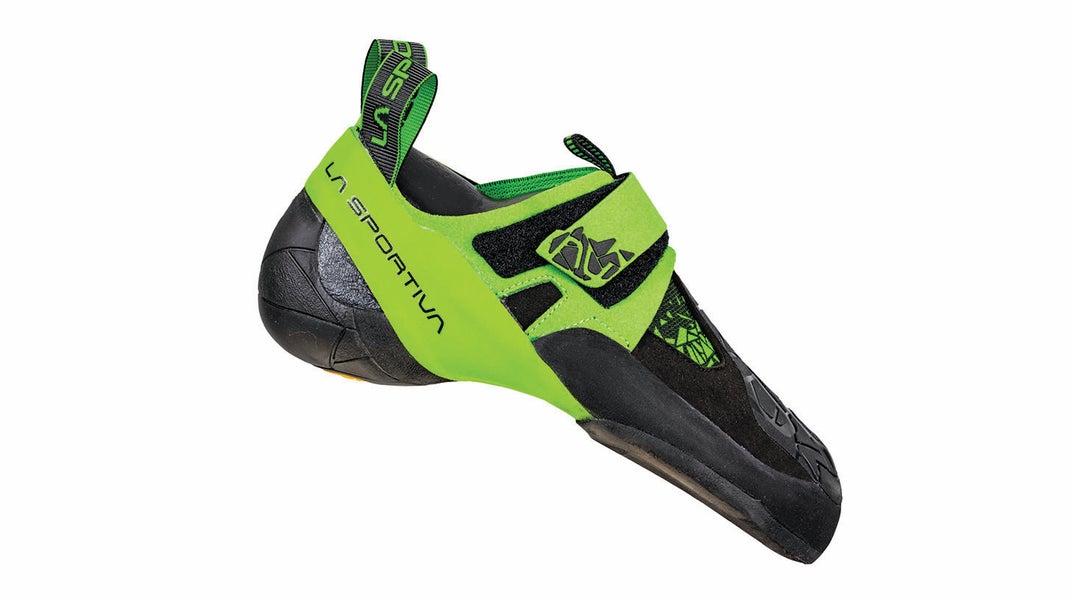
La Sportiva Vegan Skwama (NEW!)
La Sportiva’s Vegan Skwama is a high-performance slipper-velcro hybrid that’s excellent for just about everything—and animal friendly to boot. Instead of leather, the Skwama Vegan uses a “SkinLike” insole, which is as comfortable as leather and conforms to the foot like leather but (surprise!) isn’t actually leather. Though the Skwama is softer than the Solution line (both iterations), and therefore doesn’t edge quite as masterfully, it’s still a highly versatile shoe that performs well on everything from vertical basalt sport climbs to technical limestone cave boulders to marathon gym training sessions.
In sum: Great for steep boulders, not-so-steep boulders, and just about everything in between. If you’re just going to own one shoe, this should be a serious contender. But since it’s neither super soft nor super stiff, it doesn’t excel on either extreme; for pure volume climbs you may yearn for the Mantra or the Hiangle Comp, while on granite edge-fests a Solution or Booster will certainly bump your comfort up.
Sizing: our reviewer sized up a half size, which meant they were comfortable on day one. This worried him at first, since the leather version of the Skwama would have stretched out and been too large once broken in, but after two months of heavy use, his Skwama Vegan’s felt just as high precision as they did out of the box.
Price: $199
Check out the full review here.
Buy the Men’s Skwama Vegan at Backcountry
Buy the Women’s Skwama Vegan at Backcountry
*

La Sportiva Solution Comp
The winner of our 2020 Editor’s Choice award, the Solution Comp is, as the name suggests, a gym-focused retooling of the über-classic Solution that also just so happens to excel outside.
Softer and more sensitive than its relatively stiff predecessor (Beth Rodden, remember, wore Solutions when she sent Meltdown, an ultra-technical 5.14c edge-fest in Yosemite), the Solution Comp marries the toe sensitivity of today’s sock-like bouldering shoes while retaining the stiff, aggressive structure (a function of its P3 platform) for which the OG Solution is famous. The Comp has a larger toe-scumming patch and a narrower, more traditional heel—updates that pair perfectly with the OG shoe’s tried-and-true features, including the pointy, precise toe box, the downturned P3 platform for mega “bite” on steeps and micros, and the Fast Lacing System.
In Sum: If you’re looking for a bouldering shoe that can do it all—from edging t0 smearing, heeling and toe-hooking, toeing in on steeps and balancing up granite faces—the Solution Comp might be your shoe. And if you want something a bit stiffer, try out the original Solution: it’s one of the best (and most versatile) climbing shoes EVER made.
Price: $185
Buy the Men’s Solution Comp at Backcountry
Buy the Women’s Solution Comp at Backcountry
*
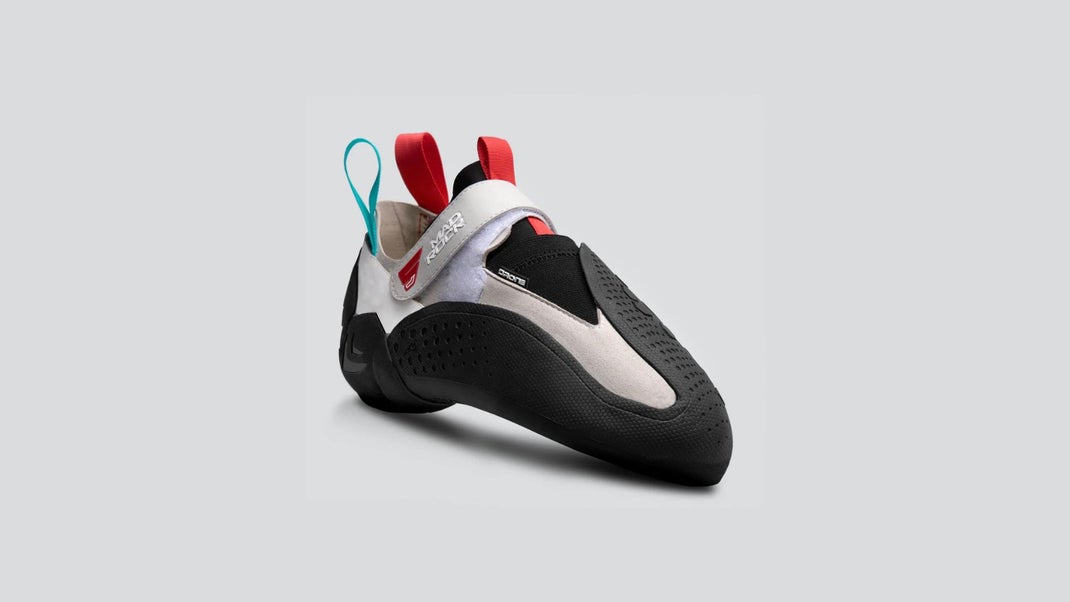
Madrock Drone Comp (NEW!)
The Drone Comp Series (CS) is a highly aggressive asymmetrical bouldering shoe—a softer counterpart to the classic Drone—that excels on steep outdoor climbs and gym volumes. What the Drone CS lacks in pure edging capabilities it makes up for with its great performance on smears and steep walls. Add to that the shoe’s comfort and reasonable price, and Mad rock has our reviewer wondering why so many of climbers pay $200+ for a pair of shoes.
In Sum: Great for: Smearing, toeing in on steep walls. Not so great for: edging, pressing powerfully off small feet, heel hooking on small edges
Sizing: Our reviewer: “For those of you new to Mad Rock: I find their sizing to be a bit more “true to size” than Scarpa and La Sportiva, where I tend to downsize a bit more. I size my OG Drones down ½ size from my street shoe, and if I was just climbing in the gym, that’s what I’d do with the Drone CS. But since the Drone CS is softer, I sometimes wish I’d gone down a full size so I had better outdoor performance on small edges.” They come in both high and low volume.
Price: $149
Read the full review
Buy the Mad Rock Drone Comp High Volume at Backcountry
Buy the Mad Rock Drone Comp Low Volume at Backcountry
*
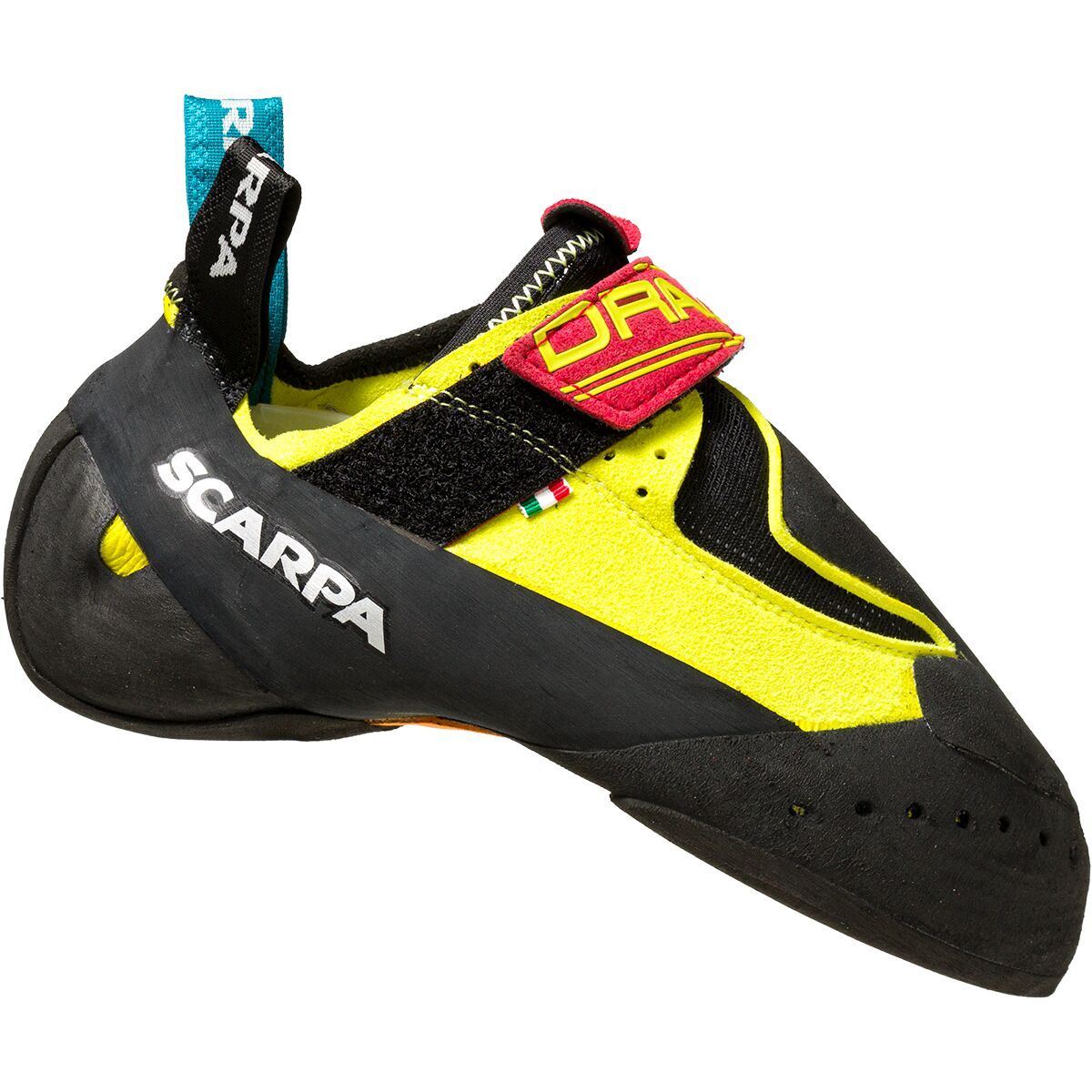
Scarpa Drago
Following a trend, one early tester noted that the Scarpa Drago is the “Ferrari LaFerrari of climbing shoes—it’s sleek and sexy, and it radiates performance. It’s a supershoe.” The Drago combines Scarpa’s best climbing-shoe features into one. It has an active rand like the Furia, which gives it precision and sensitivity, but it also has the slipper upper and heel cup of the Instinct VS, which gives a skintight fit and locked-in feel. Meanwhile the Drago has a life of its own when it comes to volume and suppleness. “It fits like a rubber sock.”
All in all, “the Drago defies standard climbing-shoe dichotomies. It’s a performance model that’s comfortable. It’s aggressively downturned yet supple enough to smear on the smallest of smidges. It’s super soft, yet can toe on tiny edges as well as, if not better than, stiff edging-specific shoes, due to the midsole. It was designed as a specialized sport, bouldering and competition shoe, yet makes an excellent all-arounder; just don’t try to crack climb in them.”
Sizing: Also available in the LV (low-volume) for climbers with narrower feet; it features Scarpa’s new PAF heel, in which the heel rand is split to reduce pressure on the Achilles tendon.
Price: $209
Buy the Scarpa Drago at Backcountry
Buy the Scarpa Drago Low Volume at Backcountry
Buy the Scrapa Drago Kids at Backcountry
*
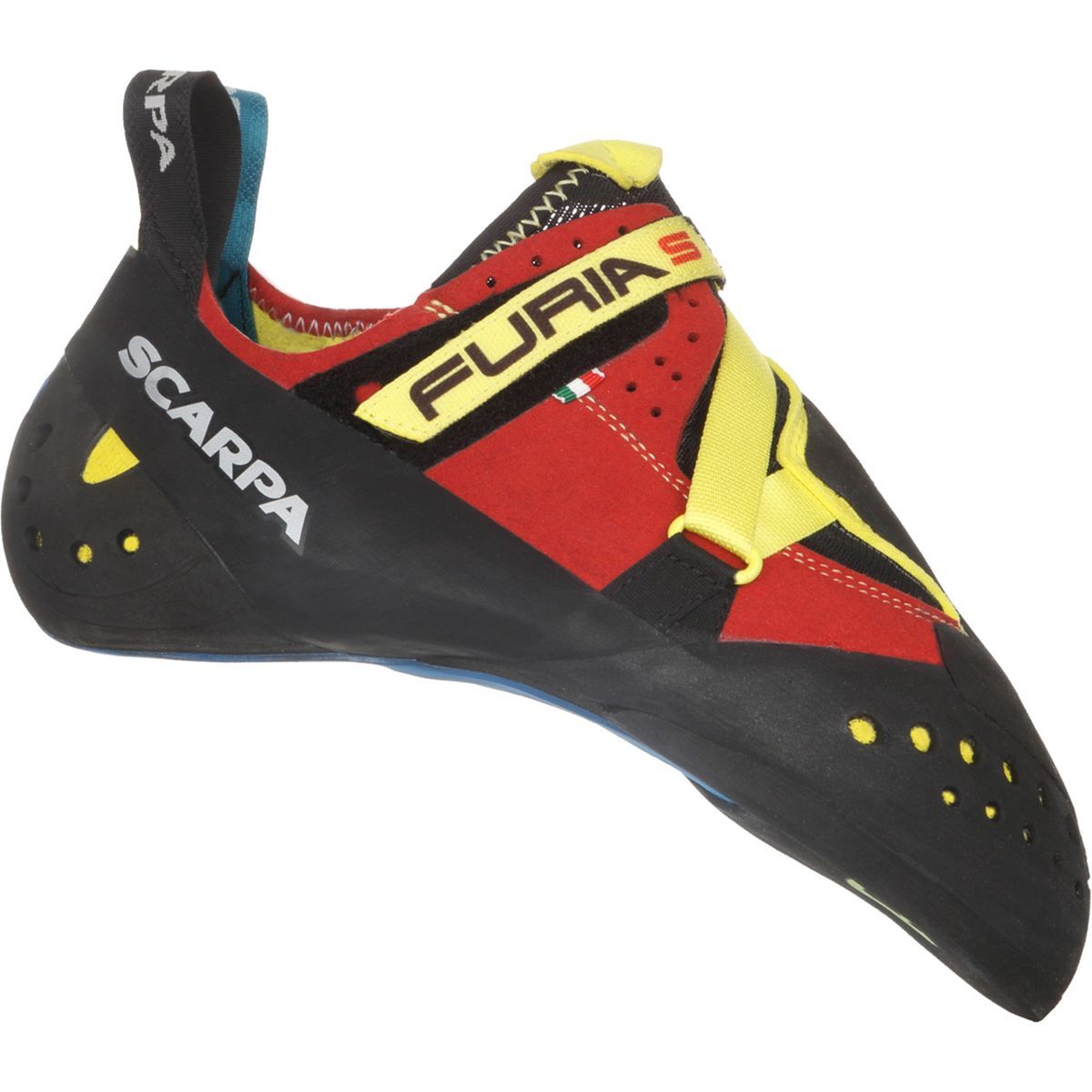
Scarpa Furia S
Described by one of our testers as “the Masarati of the Scarpa line,” the Furia S was a 2018 upgrade to one of our longtime favorites, the Furia. Designed for steep rock, the Furia S has a versatile Velcro closure system that allows you to fine-tune the way the shoe fits—though some of our testers preferred the double-velcro closure in the original Furia. The shoe’s nominal midsole gives it excellent sensitivity and the toe is “boss at digging into convavities.” If you’re planning to head to the buttermilks to tiptoe around on edges 30 feet above your pads, however, you’d be better off with something a tad bit stiffer.
Sizing: The über-soft Furia S gives enough laterally for wide feet. One tester came up one Euro size from his usual Scarpa fit.
Price: $209
Want to go even lighter and softer? Check out the Furia Air.
Buy the Scarpa Furia S at Backcountry
*
Scarpa Instinct S (NEW)
Basics: The new (2022) Instinct S is Scarpa’s third iteration of the slipper in their now 13-year-old Instinct line. Billed as the most flexible Instinct, it is a moderately downturned, mildly asymmetrical pull-on slipper with a microfiber upper, designed for steep sport (vertical-to-overhanging), bouldering, and gym climbing.
Our thoughts: The Instinct S nails the sweet spot for slipper fans who thrive on sensitivity and feedback, but who also want a solid dash of edging support for technical face, kneebars, and longer pitches. They are not as stiff and precise as the original (all-orange) Instinct S. But to offset this, the new Instinct S are much better at grabbing, heel-hooking, toe-scumming, and heel-toes: There’s a lot of glommy rubber that deforms into weird crevices and angles—the kind of funky footwork you find in modern bouldering and gyms. The shoes will favor climbers with wide feet, more so than other shoes in the Instinct line; that said, they have stretched very little thanks to the REB tech. For me, the Instinct S has been a big step up from the Instinct SR, and in the balance are nearly as good an all-around performance slipper as the original.
In sum: A very fluent all-around slipper that was reliably excellent from off-vertical/vertical terrain up to and beyond 40 degrees overhanging.
Price: $199
Read the full review here
Buy the Scarpa Instinct S at Backcountry
*
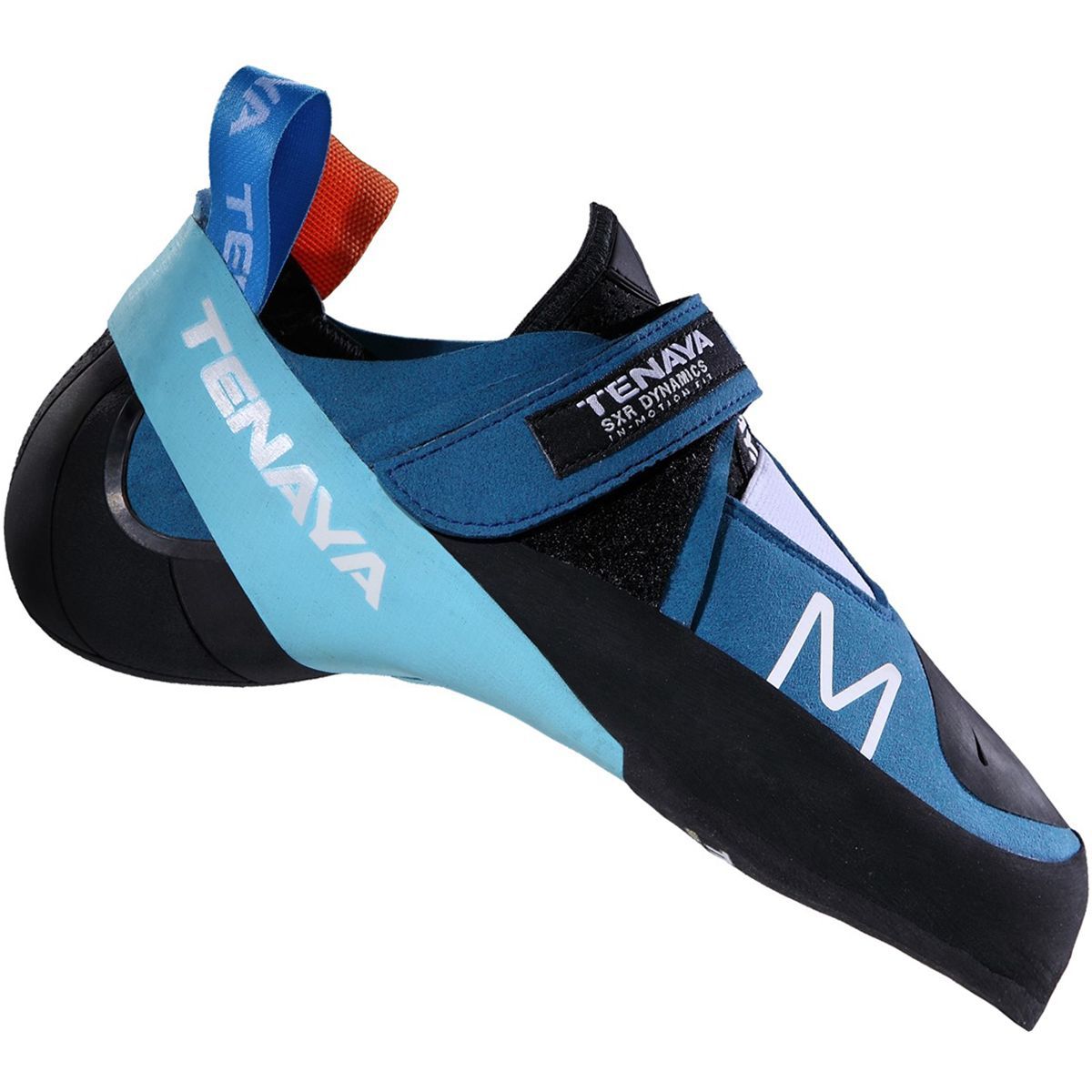
Tenaya Mastia
A favorite of Tenaya athletes like Drew Rauna, the Mastia is widely considered one of Tenaya’s best shoes. The Mastia isn’t hyper-aggressive in its shape, but it’s got a perfect fusion of softness and support, and it’s quite comfortable compared to other high performance models. The heel is tight and sensitive. Because it’s a soft shoe, lighter climbers found it high performing on all terrain while heavier climbers may find its edging abilities somewhat limited. It’s one of our editor’s absolute favorite shoe at the moment.
Fit: The Mastia is super soft and forgiving and some of our first testers wished they’d sized down more—two or more full sizes off their street shoe versus the usual 1.5 for Tenaya.
Price: $199.95
Buy the Tenaya Mastia at Backcountry
Section dividerHonorable Mentions

Butora Acro
Butora, a relatively new company based in Korea, hit it out of the park on their first attempt at an aggressive performance shoe. With a highly rubbered top-foot, super-sharp downturn, and baby-soft sensitivity, the Acro manages to push the boundaries of the high-performance spectrum. “The shoe just lasers in on precise foot placements and pockets,” one tester said after bouldering pocketed sandstone roofs in Rocktown, Georgia. “It just swoops right in there and sticks!”
Testers found that the extra-high level of performance didn’t mean sacrificing ease of wear, either. The inner sock lining drastically increased comfort, making these surprisingly wearable between burns. (That said, the Acros are not long-route boots.) A single-strap closure system at the ankle cranks down the fit, and the strip of rubber across the top of the foot makes toe hooks absolutely bomber. Keep in mind that the Acro is essentially a slipper, and it can be a pain to get them on and off right out of the box. This does get much easier as the shoe breaks in and softens up, and a piece of plastic bag over the heel helps in the interim.
Sizing: The Acro comes in two fits: A narrow blue model or wide orange model.
Price: $129
Buy the Butora Acro Tight Fit at Backcountry
Buy the Butora Acro Wide Fit at Backcountry
*
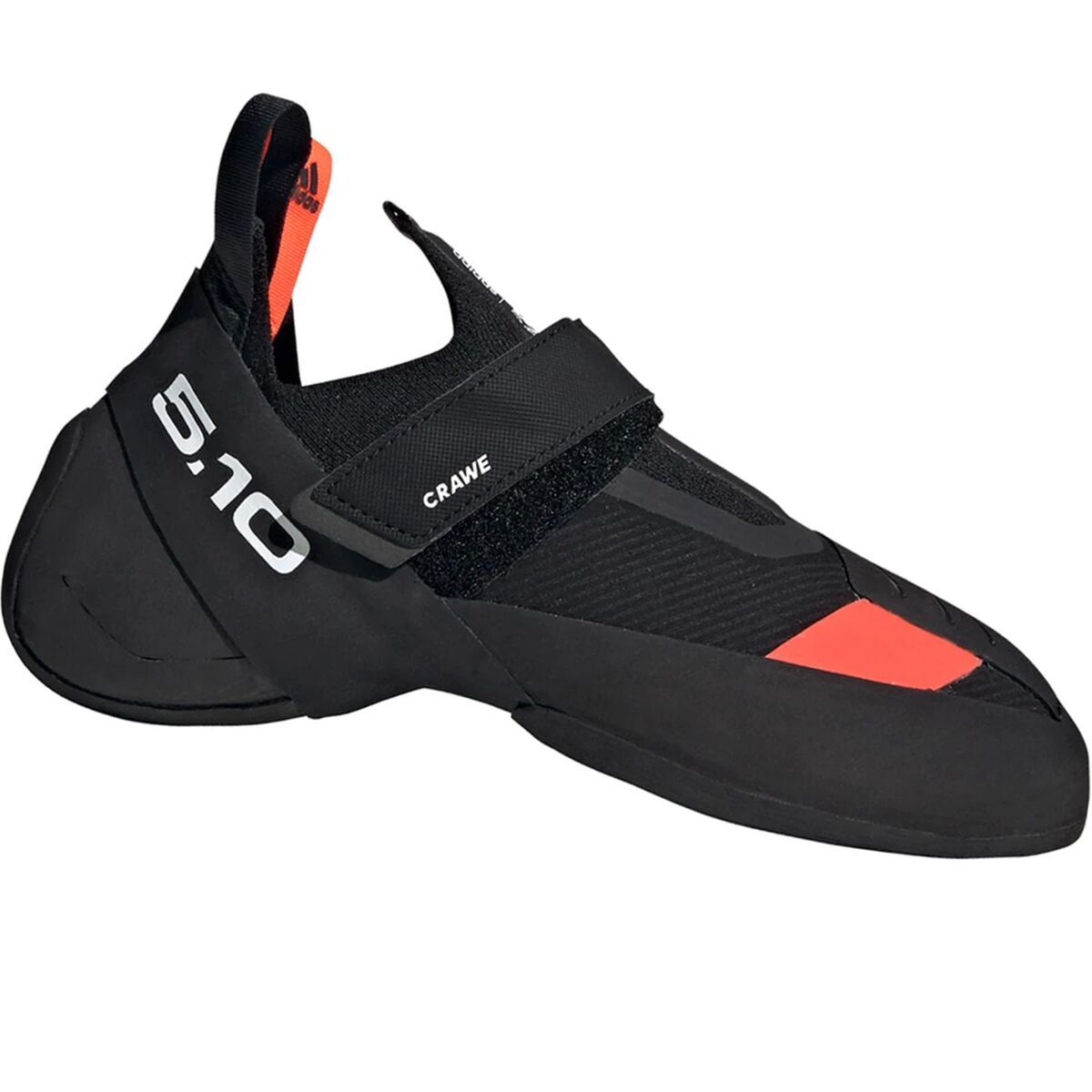
Five ten Crawe
Five Ten’s modern all-arounder is moderately downturned and slightly asymmetrical with a sensitive toe box, stiff supportive sole, soft midsole, and beefy heel. Designed for bouldering and sport climbing, the Crawes will be most attractive to gym climbers who want a shoe that can perform equally well on sub-vertical volumes, steep board climbs, and the occasional end-of-day romp up the autobelays. For more specialized climbers, or climbers who care to invest in a quiver of shoes, the Crawe can play a solid role as a training shoe, but it is unlikely to be your go-to. Outdoors, it performs adequately, but does better on high-volume days at the Red River Gorge than on precise granite boulders.
Price: $190
Read the full review here
Buy the Five Ten Crawe at Backcountry
*
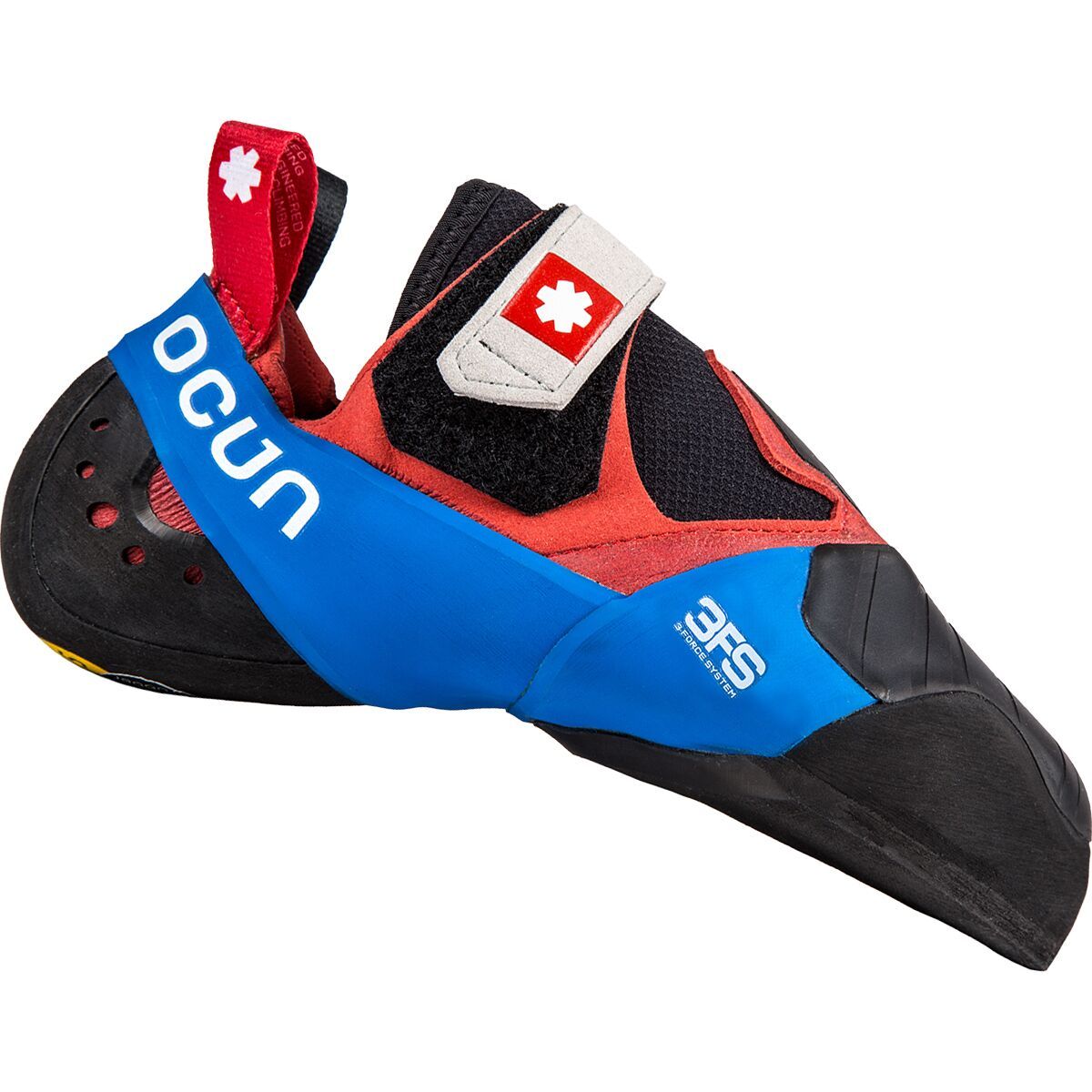
Ocun Fury
Ocun’s Fury—formerly called the Nitro—is an aggressive, asymmetrical, single-strap Velcro-closure climbing shoe designed for steep bouldering and gym climbing. It’s soft but not shapeless, and it excels equally well on MoonBoards and spray walls as it does on comp problems and—when you can find them—their outdoor counterparts. From our review: “Quite simply, the Fury excels at toeing in on steep walls, toeing around laterally distant edges (“dragoning in”), yarding on pockets, and even smearing on big, compy volumes. And it performs these tasks equally well both inside and outside. … But for vertical outdoor terrain, where precision edgework and ballerina extensions are more common, you’re definitely better off with something with a stiffer last—something you can stand on without bending in the midfoot.”
Sizing: they run very small. Our reviewer generally climbs in a European 38-38.5. But he wore his Furys in size 40.
Price: $179.95
Buy the Ocun Fury at backcountry
*
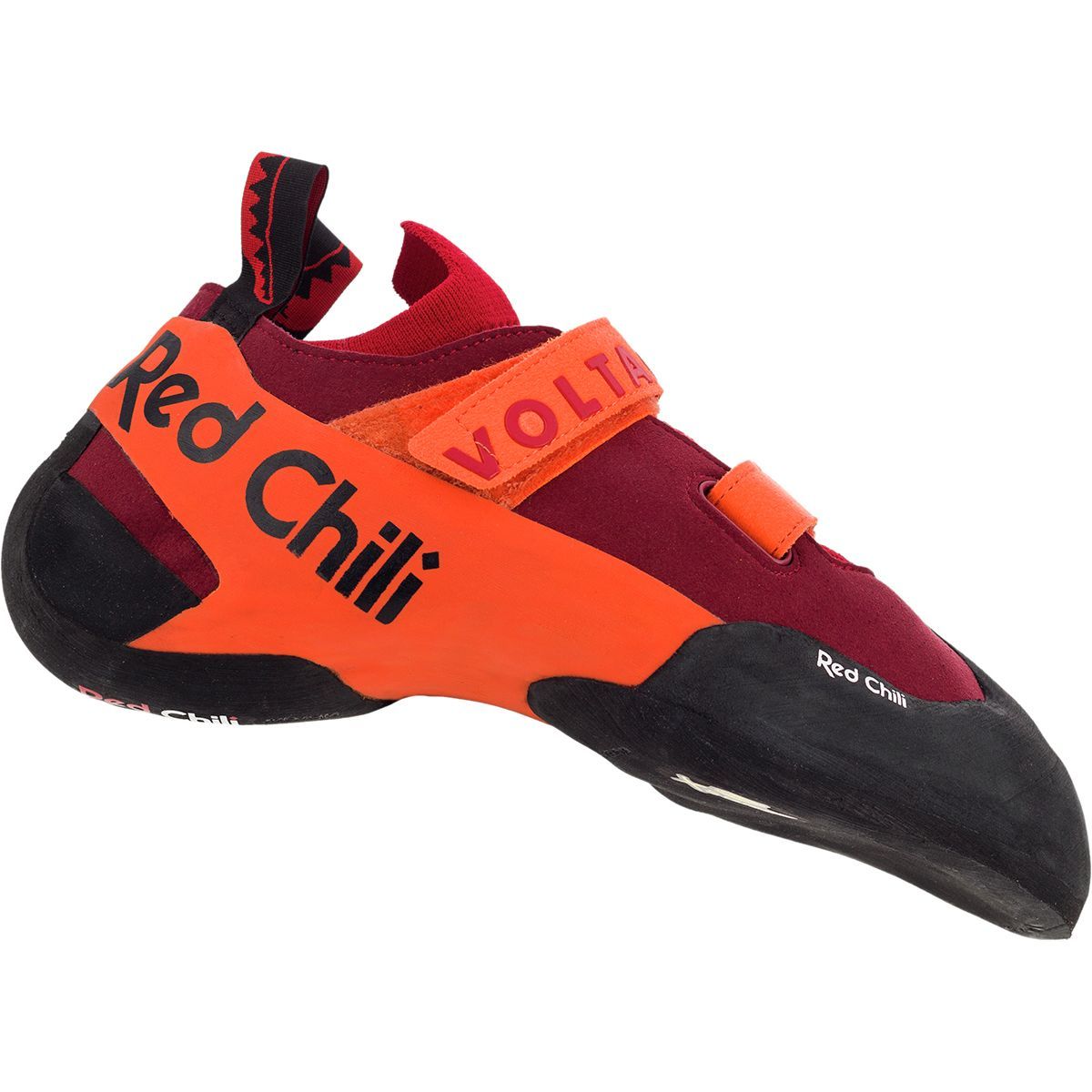
Red Chili Voltage 2
A high-performing, downturned, asymmetrical shoe that stands out largely for its comfort, this was the first Red Chili product to get properly rave reviews among our testers. One of our testers noted that the Voltage 2 was the “most perfect heel-hooking shoe I’ve ever used.” Perhaps this is because the shoe has a well-considered ample forefoot mixed with a tapered heel and only slightly extruded heel cup—the anatomical shape means that your heel stays put. It’s also a high-performing shoe on edges—though, since it’s so downturned, it falls a bit short on smears and volume climbing, which it’s not meant for. Basically, if you like aggressive shoes, intend to climb on steep walls, but can’t stomach the kind of foot pain most aggressive shoes require, the Voltage 2 is a good shoe for you.
Price: $160
Buy the Red Chili Voltage at Backcountry.com
*

Scarpa Booster
When the Booster first came out in 2007, its fierce torque plus balletic precision made it a redpointing beast. In 2020, the Booster got a makeover, with Scarpa’s new PAF heel, which splits the tension rand behind your Achilles, letting you downsize for max precision. (One of our editor’s dropped 1 size from the Booster S.) “The resulting “bite” on micros is peerless,” he writes, “and the new heel is a soft, suctiony dream.” It performs well across all angles.
Price: $209
Buy the Scarpa Booster at Backcountry
*
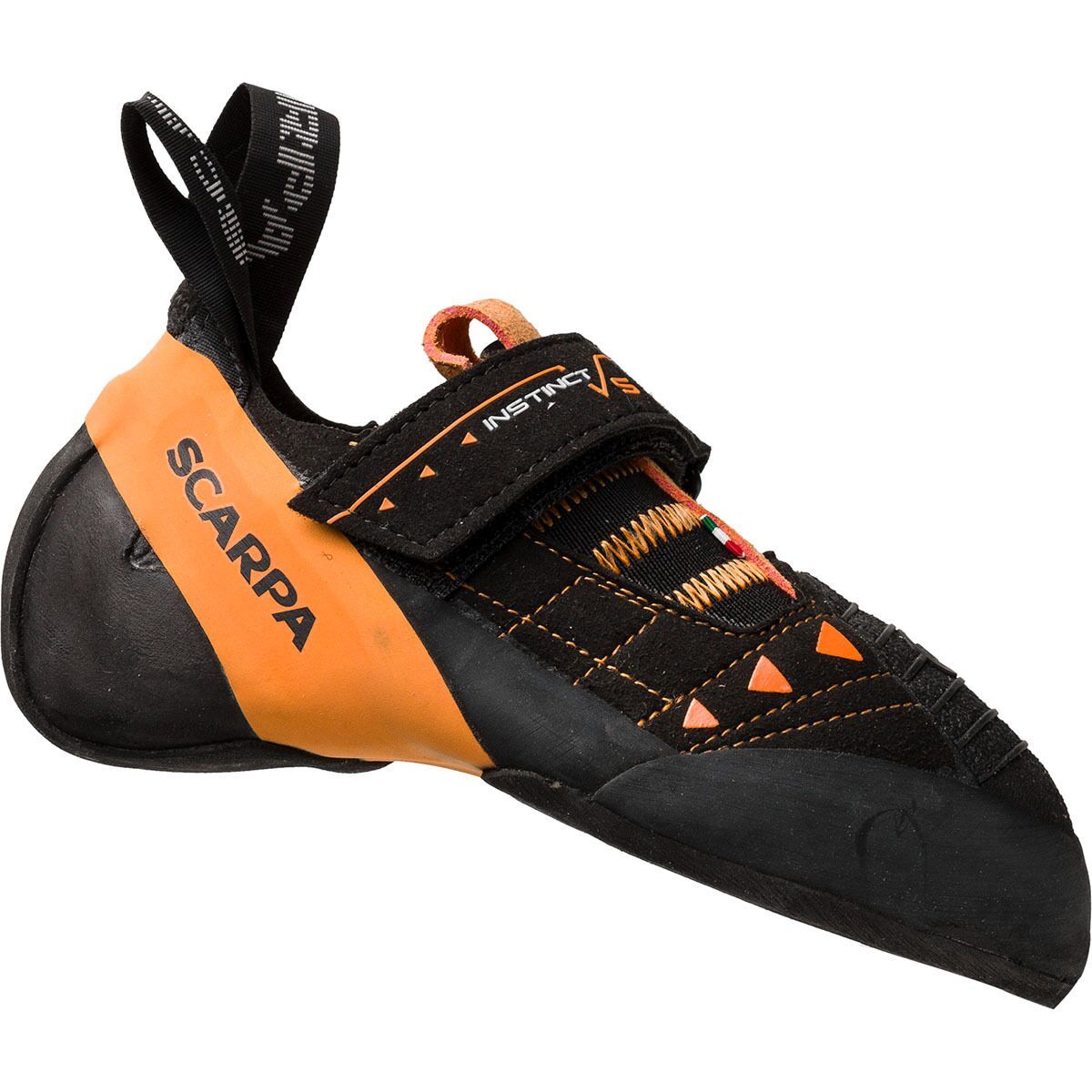
Scarpa Instinct VS
One of the most beloved shoes of the past decade, the Instinct VS is a master of all angles. When it was first released, one of our testers (who has more than 100 shoes in his personal collection) had high praise: “I’m just gonna say it: This is one of the best shoes I’ve ever worn,” he wrote. “They’re versatile, comfortable, and outperform almost any other shoe on every kind of terrain.” The Instinct VS is a single-velcro version of the successful Instinct line, which also comes in slipper and laceup versions and is being continually updated. It has unbeatable performance, super-glue-sticky Vibram XS Edge rubber, and a successful fit that tops the shoe with an elastic sock that locks the foot into place.
Want the slipper version? We also loved the Instinct SR, which won our 2019 Editor’s choice award.
Sizing. Also comes in a women’s (i.e. lower volume) version.
Price. $199
Buy the Men’s Instinct VS at Backcountry
Buy the Women’s Instinct Vs at Backcountry
*

